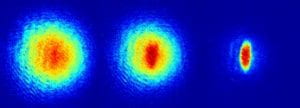
What is absolute zero? Physics tells us it is the place where all thermal motion ceases. Physicists like to use the Kelvin scale to describe temperature, where zero degrees occurs at around -273 degrees Celsius. For comparison, nitrogen, the principal component of air, freezes at 77 Kelvin, and helium (the only substance to remain a liquid all the way to absolute zero), liquefies at around 4 Kelvin.
In our laboratory we study BECs, or Bose-Einstein condensates, which are special, rarefied gases that can be cooled to temperatures below a millionth of one degree above absolute zero. That’s 0.000001 Kelvin! This temperature is so far below what we experience in everyday life that it is difficult for us to even conceive what it might feel like. All thermal motion slows to a standstill.
Here’s one way you might imagine it. Imagine navigating a busy city street on foot during rush hour, weaving in and out of pedestrians hurrying along the sidewalk. Now imagine the same sidewalk in the middle of the night, with all the pedestrians still there, but completely immobilized, as if the Zombie Apocalypse had struck around 9 PM that evening. If you were a sprite dancing on the street, you might really enjoy the freedom to move around unhindered (notwithstanding the Zombies), without anyone else accidentally moving into your way. You might even plan a dance that takes you around the whole block, and you could be sure that everyone would be there, in just the same place, when you got back. That is what it is like to dance in a world at absolute zero.
How do we measure such absurdly low temperatures? If we release our atoms from the trap that holds them up against gravity, they will slowly expand outward. After some time, we can take a snapshot of the atom cloud. The above images are of 3 separate, expanding clouds (each image is 2.7 mm x 2.7 mm and the color represents the atom density–blue means low, yellow intermediate, and red high density). Since we can calibrate the size of the atom cloud after it has expanded, we know exactly how fast the atoms were moving while trapped. From this we can deduce their temperature, which is in the neighborhood of 1 microKelvin. At this temperature, sodium atoms move at a speed of about 1 inch per second, nearly 200,000 times slower than they would at room temperature. Practically at a standstill!